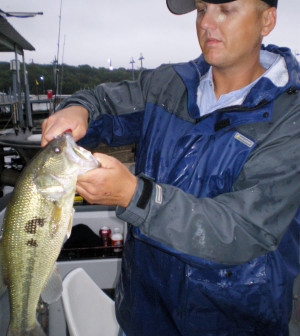This time in September has most of us who enjoy outdoor pursuits antsy for the opening day of archery season, which will provide the first chance to treat a lingering case of buck fever.
However, it’s tough to dismiss the scaly potential swimming in our state’s lakes and reservoirs, specifically largemouth bass.
The middle of September and into October is prime time for many bass die-hards, and it’s easy to see why. Boat traffic is almost nonexistent on many good waters and this transitional period holds great potential for finding lots of hungry fish. Because most forage has been pared down from spring and summer, bass are apt to take lures mimicking bait fish and other big food sources.
The No. 1 lure in the fall angler’s tackle box long has been the spinner bait. Most bodies of water aren’t as clear right now as they are during the middle of the summer, but that won’t deter bass from schooling up in search of bait fish such as shad, and even in cloudy water the fish often will come up relatively shallow.
This is where the fluttering action of a spinner bait comes perfectly into play, and instead of zipping the lure back like you would do in clear water, you should vary your retrieves, jerking and darting the lure every so often to resemble a wounded bait fish.
Texas' Cooper Lake is the best fishery you've never seen. Hybrid striped bass love the heat. http://t.co/BSOeeDZ0WE pic.twitter.com/B0Er6ZEMYS
— Will Leschper (@TXOutdoorDigest) September 3, 2013
The spinner bait also is a great choice because it can be fished easily throughout the water column, including near the bottom when bass are staging somewhat deeper. You should look for areas with lots of cover and vegetation, and then target humps, ridges and drop-offs nearby, especially on cloudy days or if the wind picks up causing large disturbances on the surface.
Other options for tempting bass with what appears to be a wounded food source are jerk baits and swimming jigs. They also can be used in a number of ways, and some of the most fun I’ve had bass fishing has come around docks and other structure this time of year with jerk baits.
The key to finding consistency often is giving the lure enough action so that bass will find it irresistible but also not pausing too long. Most days you’ll have to experiment with what the fish want, but when you find the right mix it can be downright amazing.
One thing to consider when using larger baits is how well a fish is hooked. With a lizard or other creature bait, bass often will gulp it down and you can really put a lot of pressure on them. However, if you’re using a lure with multiple trebles that’s tougher to get down it can mean that a fish may not be hooked that well. If you put too much force on a fish that’s not hooked deep, it doesn’t take long to lose it.
One lure that many anglers often overlook in the fall are topwater baits, including buzzbaits, but some of the best fishing on top occurs this time of year, especially with aggressive fish.
The easiest time to switch to a topwater is if you see birds feeding near the surface, or even better, when you actually see shad or other bait fish busting on top, and on many good bass lakes you often will find striped bass, white bass and hybrid stripers near this kind of activity, too.
Fall is a great time to find lots of aggressive fish, especially around rocky areas and back creek channels and coves. Another top-shelf bait choice is anything resembling a crawfish, including crankbaits or sassy shads, and Carolina-rigged baits bounced near the bottom can be the ticket to finding smallmouths whether there are bait fish around or not on waters that harbor the distinct specimens.
If you happen to find yourself a lucky angler catching a true lunker beginning next month, don’t forget about the Toyota ShareLunker program, which starts Oct. 1 and runs through April 30. The program accepts largemouths 13 pounds or larger to use in a selective breeding program at the Texas Freshwater Fisheries Center in Athens.
Click here for more on the program.


















